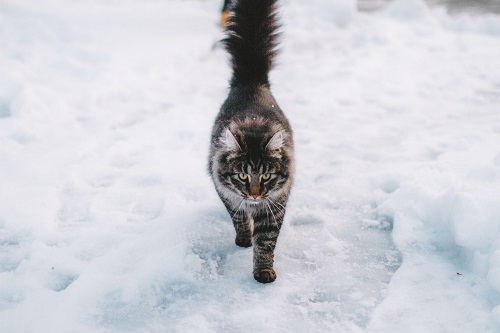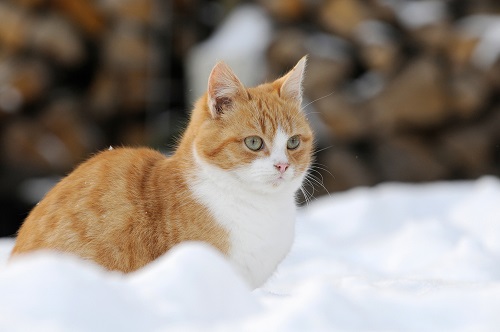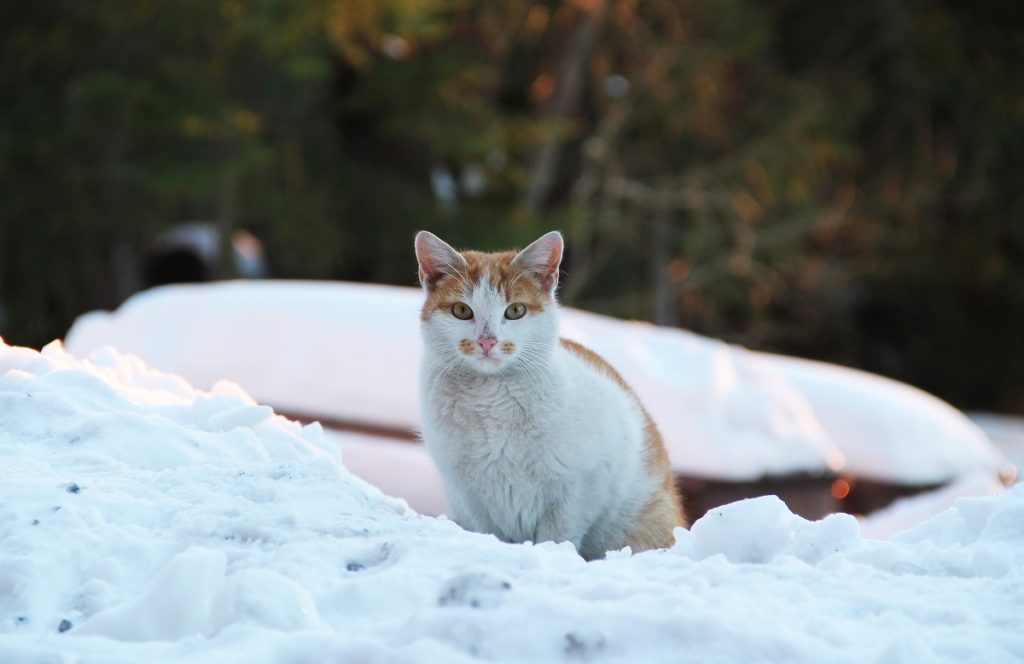One of the greatest winter perils that threaten outdoor dwelling cats is the dangerous condition of frostbite. Frostbite is the long term exposure to freezing temperatures. Unfortunately for cold-weather cats, the colder the temperature drops, the quicker frostbite sets in. Additionally, direct exposure to ice, snow, or sleet can exacerbate the symptoms of frostbite and speed up the timeline. While you may think that fur would keep felines safe from frostbite, the reality is that cats are quite susceptible to this debilitating condition. Here is a helpful guide for recognizing, treating, and preventing feline frostbite.
Causes of Frostbite on Cats
Frostbite is a visible symptom of skin tissue dying. Tissue death occurs when ice crystals become integrated with skin cells, creating irreversible damage to every layer of the skin, including the sensitive nerve endings.
Certain surfaces amplify the negative effect of cold conditions and as a result, can be perilous for cats in the wintertime. Metal is a surface that tends to be much colder than the outside temperature. Even if it is not technically freezing, metal can retain a chill, which results in a colder temperature than the air or the ground.
Water, wind, and ice are all contributors to the threat of frostbite in both dogs and cats as well. Wind chill can drastically reduce temperatures, creating unsafe conditions for a cat to be outdoors. Additionally, a cat with a wet coat in freezing temperatures faces the threat of ice forming directly on the skin. Any excess moisture that exists on the skin’s surface poses a potential threat to healthy skin in freezing conditions.
Symptoms of Frostbite in Cats
Frostbite commonly affects the paws, tails, and ears of cats, but can occur all over. Felines have very sensitive paws, and the skin can quickly become the victim of frostbite if exposed to extreme cold. Frostbite has a wide range of outcomes and depending on how severe the case is, can lead to the loss of extremities. 
Here are some easily recognizable symptoms of frostbite in cats:
- Loss of fur
- Red, swollen skin
- Cold, numb extremities – especially in the paws, ears, and tail
- Visible ice stuck to the skin
- Dark black splotches on the skin
- Gnawing and scratching at the affected area
- Swelling
- Blisters
- Blue and gray coloration to the skin
It should be noted that a cat who has suffered the effects of frostbite will likely not feel pain right away. The numbing effects of the extreme cold will delay any sensation of pain that comes as the result of the skin tissue dying.
Diagnosis
If you fear your cat has suffered early onset frostbite, contact your vet immediately. The faster you can treat the affected area(s), the higher the chance of saving any skin that may have been exposed. Here are some actions you can take, even before seeing a vet.
- Wrap your cat in a warm towel to return circulation to the extremities
- Apply a warm, moist compress to the affected area
- Do not let the area dry out as it could speed up the death of cells leading to increased severity
- Apply aloe vera to the affected area to assist with moisture retention
- Do not rub the affected skin
As always, leave all diagnoses and treatments to your trusted veterinary professional. The tips above should only be implemented as a short term solution if you are unable to speak with or see your vet right away.
Treatment of Frostbite in Cats
 Short-term care for frostbite is often characterized by the removal of any dead skin tissue. The removal of dead skin could help new skin to grow in its place, but in extreme circumstances, a skin graft may be required. Usually, long term care for frostbite includes a variety of topical solutions that aid in the growth of new skin cells and prevent the spread of bacteria and viruses on the skin. In extreme cases, amputation may be necessary at which point recovery becomes a more involved process. Most frostbite caught in the early stages is entirely treatable, allowing cats to make a full recovery.
Short-term care for frostbite is often characterized by the removal of any dead skin tissue. The removal of dead skin could help new skin to grow in its place, but in extreme circumstances, a skin graft may be required. Usually, long term care for frostbite includes a variety of topical solutions that aid in the growth of new skin cells and prevent the spread of bacteria and viruses on the skin. In extreme cases, amputation may be necessary at which point recovery becomes a more involved process. Most frostbite caught in the early stages is entirely treatable, allowing cats to make a full recovery.
Frostbite Prevention
The easiest way to prevent frostbite in cats is to keep your cat indoors. If you notice a cat that has been left outside in freezing temperatures, contact animal control. Never try to bring a stray cat into your home as he could be farrell and potentially dangerous to you and your family. Animal Control is trained in how to deal with, and assist, stray animals. The best way to help animals in need is to notify a professional who can help.
Your cat may act cool, but he hates being left out in the cold. Take the necessary precautions with your cat and monitor outdoor temperatures. Limit your cat’s exposure to severe weather, and if he is let out in the cold, make sure he is bundled up properly. Frostbite is entirely preventable, and it is your job as a pet owner to keep your cat safe.
Sources:
Fries, W. C. (n.d.). Pet Winter Safety: Prepping Your Pet for Winter Weather. Retrieved from https://pets.webmd.com/features/pet-winter-safety-prepping-your-pet-for-winter-weather#3
Wondra., S., & Knetter, M. (2013, December 30). Frostbite in Dogs and Cats: How to Handle it, How to Prevent It. Retrieved from https://www.petcarerx.com/article/frostbite-in-dogs-and-cats-how-to-handle-it-how-to-prevent-it/1551
Frostbite in Cats. (2016, December 12). Retrieved from https://www.petmd.com/cat/emergency/common-emergencies/e_ct_frostbite
Frostbite in Cats. Retrieved from https://vcahospitals.com/know-your-pet/frostbite-in-cats
Frostbite in Cats – Symptoms, Causes, Diagnosis, Treatment, Recovery, Management, Cost. (2016, November 9). Retrieved from https://wagwalking.com/cat/condition/frostbite




